|
|
|
|
|
|
 |
|
|
|
CRAZY
HORSE MEMORIAL
Carving Legacy
Of Great Indian Chief
Continues On Peak in The Black
Hills
RAZY HORSE is the legendary
fighting hero in the annals of the Sioux struggle against
encroaching white settlers and the U.S. Army in the area of
of the Plains and what is today South Dakota. Among other
feats, Crazy Horse led the charge at the Battle of Little
Bighorn that decimated Gen. Armstrong Custer and his 7th
Cavalry.
In 1942 Mari Sandoz
(1876-1966) wrote a comprehensive history of the Oglala
Indian chief in her book,
Crazy Horse.
In 2008 the University of Nebraska Press released the third
edition of the book (soft cover, 481 pages,
$15.95,
Amazon.com Price: $10.85).
Read this enthralling
book to prepare for a fascinating visit to the
Crazy Horse Memorial
in the Black Hills, sacred
Indian ground in South Dakota.
Korczak Ziolkowski, a
prominent Boston sculptor, began a lifelong project to
memorialize the epic story of Native Americans with his
sculpture of Crazy Horse on a mountain (and a nearby
educational/cultural visitor complex). At age 39 he began to
carve the mountain with his first blast in 1948.
He turned down $10
million in federal funding, relying strictly on public
financing. A government that broke promises to its Native
Americans should have no official say in a memorial to Crazy
Horse. Besides, just four miles north is Mount Rushmore,
where work stopped when the sculptor died. Korczak did not
want his project to terminate with his demise.
Korczak died in 1982
at age 74, leaving a wife and 10 children. The widow, Ruth,
vowed to continue her husband’s dream. A third generation,
under Ruth’s direction, is determined to carry on Korczak’s
work. You too can become part of history by donating to this
effort at
www.crazyhorsememorial.com.
You can see the
progress being made on charts in the visitor center
(605.673.4681). On most days in the summer you can see the
flash and hear the blasts of dynamite on the peak as work
progresses.
A scale model of the
finished memorial, at the Visitor Center, shows the Oglala
Sioux military leader on his steed with his arm pointing
forward. You can just hear his words: "My lands are where my
dead lie buried."
Contact
Michelle Thomson, tourism director, at Rapid City Convention
& Visitors Bureau. Email
thomson@visitrapidcity.com,
phone 605.718.8489.
|
|
Back to Top
|
|
|
|
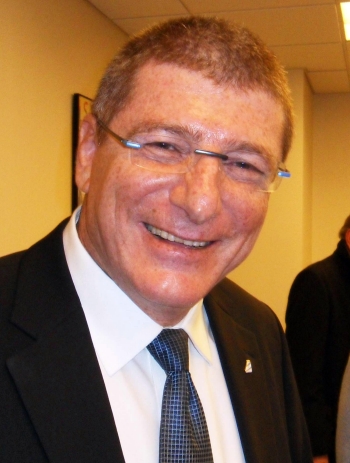
Shkedi |
ISRAEL
EL AL Chief Sees It
So Small, Yet So
Vast
SRAEL is so unique, says
Elyezer Shkedi of EL AL Israel Airlines, that you can go
from the Dead Sea to the Sea of Galilee, from the desert of
Negev to the snow of the Golan Heights. "It’s amazing," he
said at a press conference in March in New York.
Shkedi, who assumed
the role of president/CEO in January 2010, said that the
number of tourists are now higher than the year before.
"This small piece of land, inhabited by Jews, Christians and
Muslims, attracts 3.5 million visitors a year. It should be
more. Our goal should be 25 million."
Israel is a very safe
place, he added. "People who come to Israel feel safer than
any other place. It looks different on TV than in real
life."
Shkedi reported that
EL AL has purchased a Boeing 747-400 jumbo in March for the
US/Israel route and ordered four Boeing 737-900ER for
shorter routes.
"We are trying to
improve our fleet with the 767-300. We intend to be the best
narrow-bodied airline by 2013."
Shkedi also
introduced Danny Saadon as the new vice president of EL AL
in North and Central America. Saadon spent the past five
years as the airline’s vice president and general manager in
Tel Aviv. In his five decades with EL AL, Saadon has been
involved in several major humanitarian operations, including
the 1976 raid on Entebbe to rescue hostages, the airlift of
Israelis in Tehran during the 1978 Iranian revolution, and
the covert 1991 Operation Solomon that delivered
15,000 stranded Ethiopians to Israel.
|
|
Resources
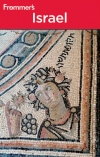 FROMMER’S ISRAEL This sixth edition
is all the guidance you need to get around the
country, from the Galilee (Nazareth, Tiberias, Safed,
Golan Heights), through the Golden Coast (Haifa,
Netanya, Caesarea, wine country), to Haifa, Tel
Aviv, Jerusalem, the Dead Sea and Negev (Beersheba,
Masada, Qumram, Eilat), and over the Jordan border
for a side trip to ancient Petra, which no tourist
can afford to miss as long as you’re in the
neighborhood. History 101 gives you a short history
of Israel, plus notes on famous people, and pages
describing street food, dining customs (kosher), and
recommended books and films. This guidebook is quite
up-to-date, quite detailed and quite an easy read.
(Wiley, paperback, 544 pages,
$23.99,
Amazon.com Price: $16.31) FROMMER’S ISRAEL This sixth edition
is all the guidance you need to get around the
country, from the Galilee (Nazareth, Tiberias, Safed,
Golan Heights), through the Golden Coast (Haifa,
Netanya, Caesarea, wine country), to Haifa, Tel
Aviv, Jerusalem, the Dead Sea and Negev (Beersheba,
Masada, Qumram, Eilat), and over the Jordan border
for a side trip to ancient Petra, which no tourist
can afford to miss as long as you’re in the
neighborhood. History 101 gives you a short history
of Israel, plus notes on famous people, and pages
describing street food, dining customs (kosher), and
recommended books and films. This guidebook is quite
up-to-date, quite detailed and quite an easy read.
(Wiley, paperback, 544 pages,
$23.99,
Amazon.com Price: $16.31)
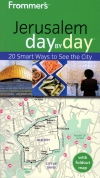 FROMMER’S JERUSALEM
DAY BY DAY
What a handy booklet! It fits
right in your hand as you focus your camera with the
other. The sturdy front cover folds out to reveal a
laminated map of the central city on one side and
the Old City on the other side. The last page is
actually a plastic envelop that holds a full size
map of Jerusalem. Cleverly laid out, this guidebook
shows how to visit the various sites, holy and
otherwise, in the most efficient manner one day at a
time. (Wiley, paperback, 184 pages,
$13.99,
Amazon.com Price: $11.89) FROMMER’S JERUSALEM
DAY BY DAY
What a handy booklet! It fits
right in your hand as you focus your camera with the
other. The sturdy front cover folds out to reveal a
laminated map of the central city on one side and
the Old City on the other side. The last page is
actually a plastic envelop that holds a full size
map of Jerusalem. Cleverly laid out, this guidebook
shows how to visit the various sites, holy and
otherwise, in the most efficient manner one day at a
time. (Wiley, paperback, 184 pages,
$13.99,
Amazon.com Price: $11.89)
|
|
|
Back to Top
|
|
|
|
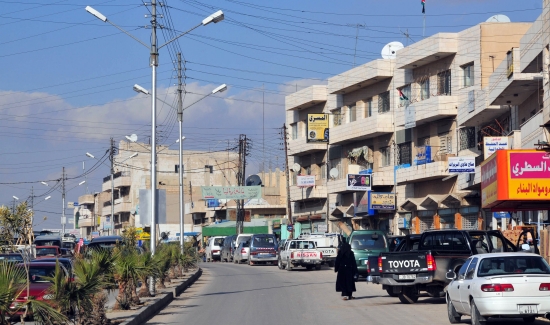
Madaba street scene |
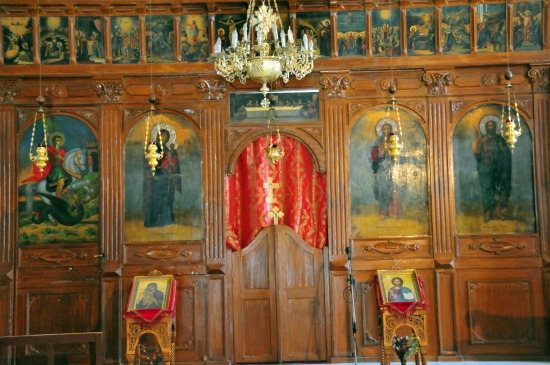
St. George’s Greek Orthodox Church |
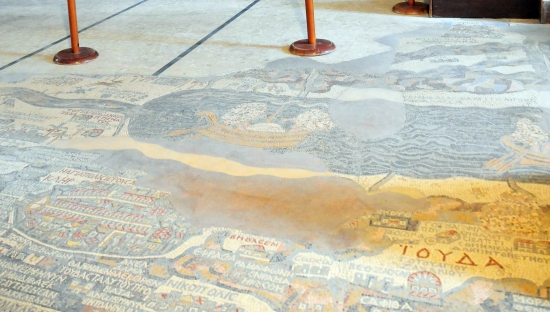
Mosaic map in St. George’s Church |
JORDAN
City Of Mosaics Thrill
Visitors To
Madaba
OZENS of mosaics are to be
found in various churches and homes in Madaba, a charming
market town just 45 minutes southwest of Amman, and close to
Mount Nebo and Bethany. The presence of elaborate mosaics
testifies to the importance of Madaba as a Byzantine
ecclesiastical center.
After the Persian
invasion in the seventh century, the town lay abandoned
until the 19th century when it was resettled by
Christians. As they dug foundations for their homes, they
discovered the ancient mosaics.
The most famous
mosaic artwork is to be seen in St. George’s Church.
This is a sixth
century Byzantine mosaic map made up of more than two
million pieces of colored stone, laid out on the floor of
this Greek Orthodox church. This masterpiece depicts
Jerusalem and hills and valleys in the ancient Middle East.
It is reputedly the earliest religious map of the Holy Land
to survive from antiquity.
This exquisite
treasure was discovered in 1884 during construction of a new
sanctuary on the site of an ancient Byzantium church. The
map originally depicted all major biblical sites from
Lebanon to Egypt. The map identified Bethany, which led
archeologists to discover Bethany nearby as the site where
John baptized Jesus. Pope Benedict XVI visited the place in
May 2009.
The art of mosaics
has been part of the tradition of Madaba since ancient
times. You can watch artists create intricate mosaics which
are sold in the many souvenir and handicraft shops. Also on
display are rugs, silver, traditional dresses and Dead Sea
products.
Christians make up a
third of Madaba’s population of 135,000. Jordan’s population
of 6.2 million is 92 percent Sunni Muslim, while 6 percent
are Christian, mainly in Madaba, Amman, Salt and Karak. The
majority of them are Greek Orthodox, with a sprinkling of
Coptic, Armenian, Syrian and Catholic believers.
The well-run Madaba
Visitors Center is located near the church. Phone 08-543-376
(closed Friday). More information at
www.visitjordan.com.
|
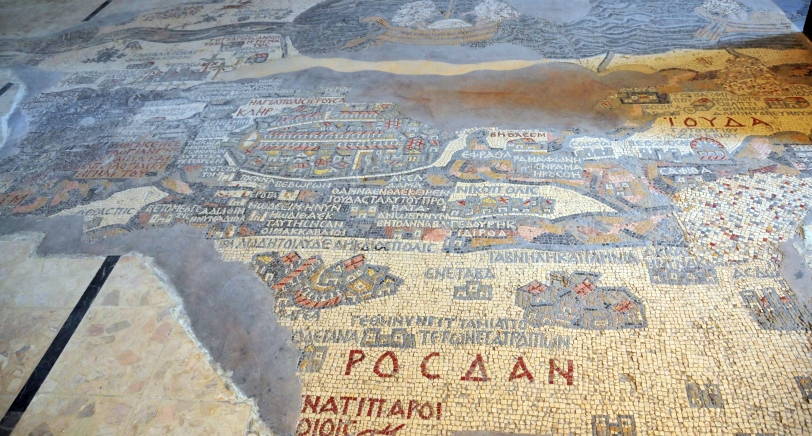
Close-up of mosaic map |
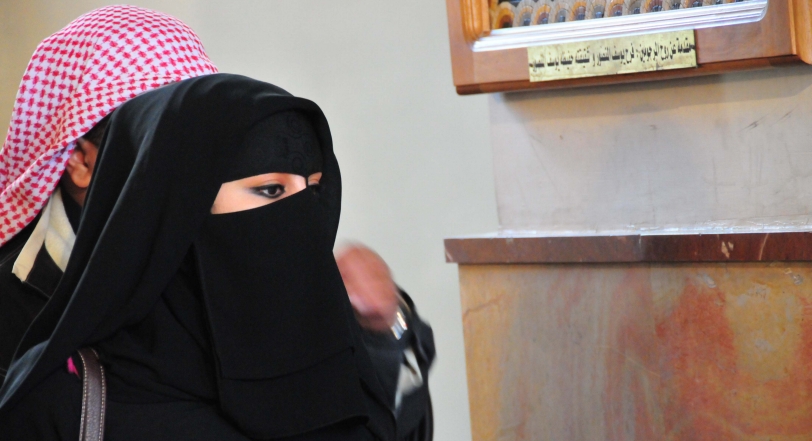
Tourists in St. George’s Church |
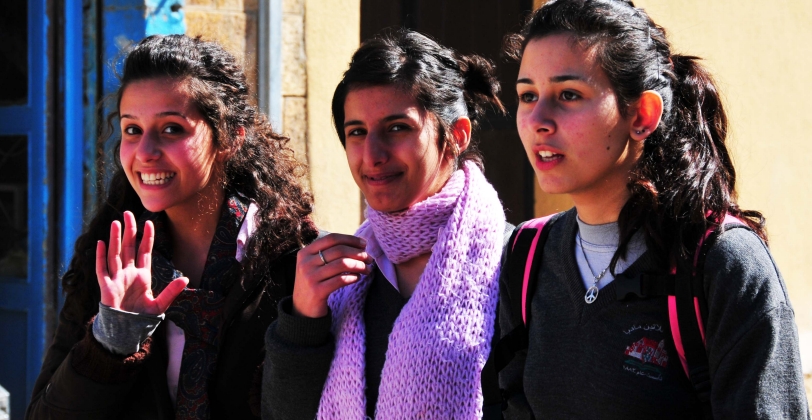
Greeting a visitor |
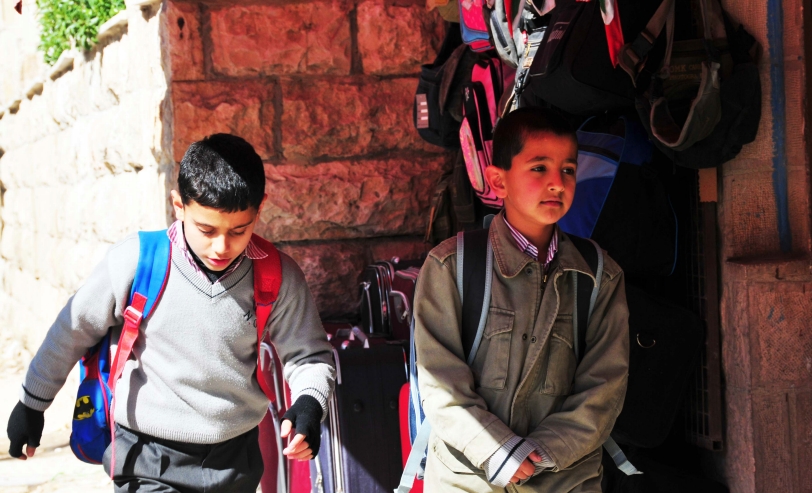
Coming from school |
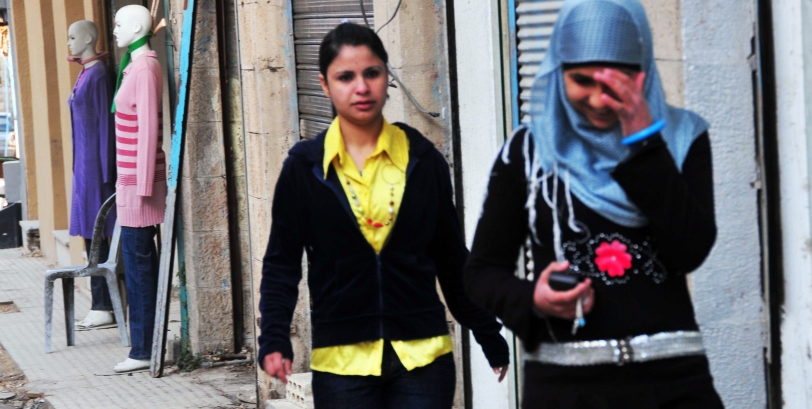
Contrast in style |
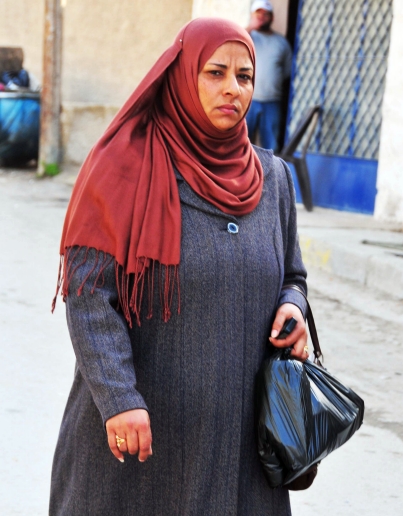
Traditional attire |
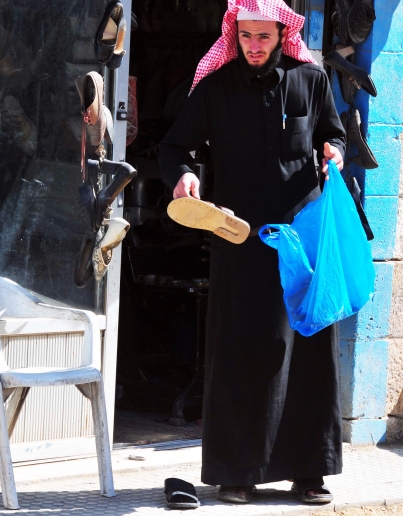
Buying shoes |
|
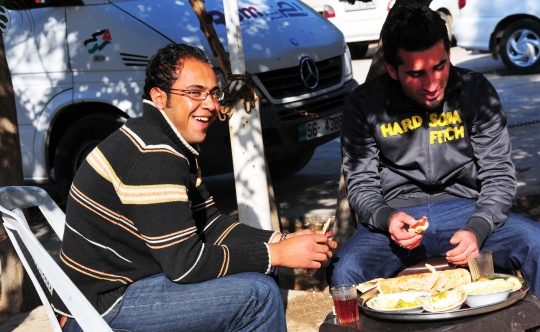
Lunch under the trees |
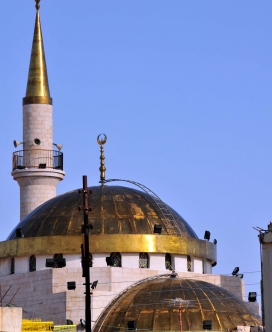
Madaba mosque |
|
|
Resources
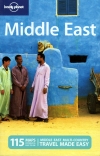 MIDDLE EAST
This Lonely Planet edition covers everything from
Egypt all the way up to Turkey, sweeping across
Israel, the Palestinian Territories, Lebanon, Syria,
Iraq and, of course, Jordan. Helpful advice
throughout. Best time to travel in these countries
is autumn (September to November) or spring (March
to May). "There’s nothing worse than arriving in the
Middle East to discover that it’s Ramadan and
stinking hot." Beware that overnight temperatures in
winter can plummet in desert areas. I should have
studied this book before leaving home totally
unprepared for the frigid elements on a recent
February. In an exhilarating jaunt to Jordan I
visited a Bedouin camp in the mysterious Wadi Rum.
After an evening of the warmest desert hospitality,
consisting of food, dancing and singing before a
blazing camp fire, I retired for the night in a tent
and almost froze to death. (Lonely Planet, 6th
edition, May 2009, softcover, 700 pages,
$28.99,
Amazon.com Price: $19.13) MIDDLE EAST
This Lonely Planet edition covers everything from
Egypt all the way up to Turkey, sweeping across
Israel, the Palestinian Territories, Lebanon, Syria,
Iraq and, of course, Jordan. Helpful advice
throughout. Best time to travel in these countries
is autumn (September to November) or spring (March
to May). "There’s nothing worse than arriving in the
Middle East to discover that it’s Ramadan and
stinking hot." Beware that overnight temperatures in
winter can plummet in desert areas. I should have
studied this book before leaving home totally
unprepared for the frigid elements on a recent
February. In an exhilarating jaunt to Jordan I
visited a Bedouin camp in the mysterious Wadi Rum.
After an evening of the warmest desert hospitality,
consisting of food, dancing and singing before a
blazing camp fire, I retired for the night in a tent
and almost froze to death. (Lonely Planet, 6th
edition, May 2009, softcover, 700 pages,
$28.99,
Amazon.com Price: $19.13)
|
|
|
|
|
|